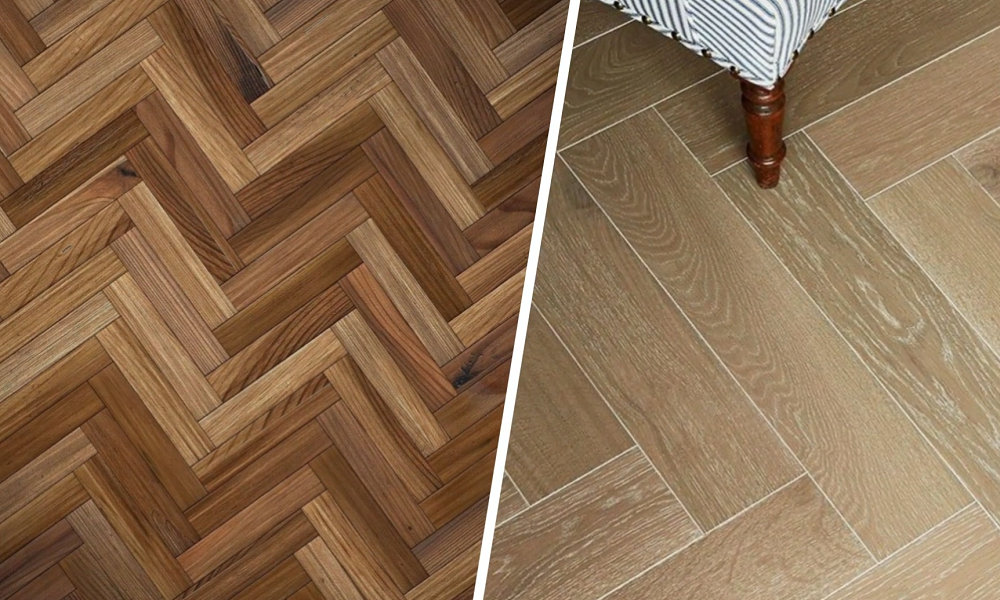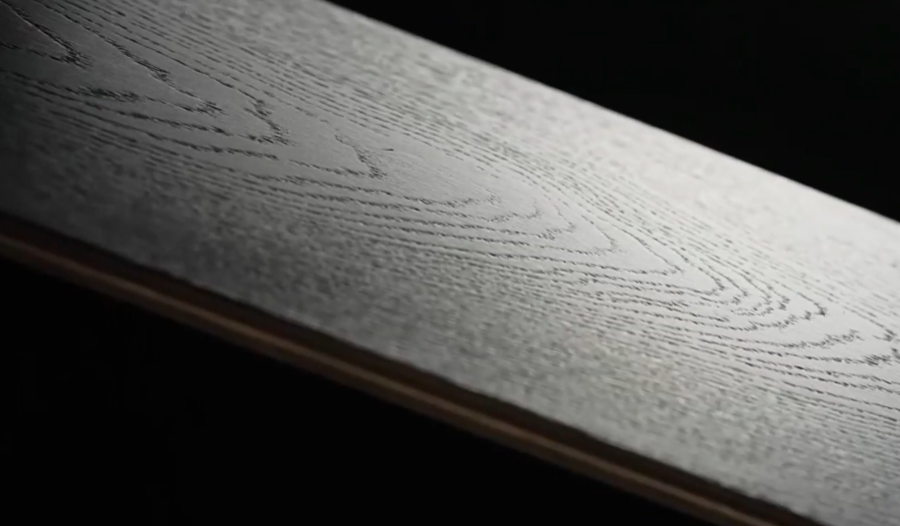NEWS TAG
brand
What is Parquet Flooring & Difference with Hardwood/Herringbone/Laminate
When choosing flooring, homeowners often seek options that bring style and character to their interiors. Parquet flooring has long been favored for adding timeless elegance and warmth to any home. If you are considering parquet, hardwood, herringbone, or laminate flooring, this guide will help clarify what each option offers and how they compare, so you can select the most suitable floor for your needs and taste.

What is Parquet Flooring?
Parquet flooring is a special type of hardwood flooring known for its unique and intricate patterns. The floor is constructed from individual wooden pieces, usually small strips or blocks, arranged in geometric designs. These patterns, such as herringbone, chevron, basket weave, and more, add sophistication and visual appeal to any room.

This flooring is available in a variety of wood species, including oak, walnut, and cherry, each contributing its own distinctive color and grain. Parquet can be made from solid wood blocks or as engineered parquet, which features a real wood top layer bonded to multiple layers of plywood. The engineered variety offers added stability and resistance to moisture and temperature changes, while solid parquet provides unmatched durability and can be sanded and refinished several times.
Parquet’s design versatility allows it to fit with traditional, modern, or eclectic interiors, making it a popular choice for hallways, living rooms, bedrooms, and commercial spaces.
Pros and Cons of Parquet Flooring
Advantages
Aesthetic Appeal: Parquet offers a visually striking appearance with its geometric patterns, bringing elegance and charm to any area.
Design Versatility: Homeowners can choose from various patterns and wood species, allowing for customization to match any décor.
Durability: Made from quality materials like solid or engineered wood, parquet handles heavy foot traffic and resists scratches and dents.
Easy Maintenance: Regular sweeping or vacuuming and occasional mopping keeps parquet floors looking their best.
Long Lifespan: With proper care, parquet can last for decades, making it a long-term investment.
Healthier Environment: Parquet does not trap dust, pollen, or pet dander, making it a good option for allergy sufferers.
Temperature Regulation: Wood’s natural insulating properties help maintain comfortable indoor temperatures.
Disadvantages
Complex Installation: Installing parquet is a detailed process requiring accurate measurements and skilled craftsmanship, which can increase costs.
Moisture Sensitivity: Excess moisture can cause warping, swelling, or cupping of the wood, so it is not ideal for bathrooms or damp basements.
DIY Limitations: Due to the complexity and need for specialized tools, parquet flooring is not usually a DIY project unless you have experience.
Refinishing Limits: The number of times you can refinish parquet depends on the thickness of the top wood layer. Thicker layers allow for more refinishing cycles.
Parquet Flooring Types
Parquet flooring is available in several forms to fit different preferences, performance needs, and budgets. The most common types include:

Solid Parquet:
This type consists of blocks or strips made entirely from solid wood. Solid parquet provides outstanding longevity and can be sanded and refinished multiple times throughout its life. It offers the authentic feel and warmth of natural wood, making it a favorite for those who appreciate traditional craftsmanship.
Engineered Parquet:
Engineered parquet features a top layer of real wood adhered to multiple layers of plywood. This construction increases resistance to moisture and temperature changes, making engineered parquet less likely to expand, contract, or warp. It’s a practical choice for spaces where humidity levels fluctuate.
Herringbone Parquet:
Herringbone is a specific style of parquet where rectangular wooden blocks are arranged in a zigzag pattern, resembling the bones of a herring fish. This classic design adds movement and sophistication to a room. While herringbone is often considered its own category, it is fundamentally a type of parquet flooring due to the way blocks are laid.
Other Patterns:
Parquet flooring can also be crafted into a wide range of geometric designs beyond herringbone. Patterns such as chevron, basket weave, and Versailles panels each bring their own unique visual effect, allowing homeowners to select a style that fits their taste and the character of their room.
Each parquet type can be selected in various wood species, such as oak, walnut, or cherry, offering different colors, grain patterns, and levels of durability. The choice between solid and engineered, as well as the pattern, depends on your design vision and practical requirements for your space.
How To Install Parquet Flooring?
Although professional installation is recommended for parquet, understanding the general process helps appreciate the craftsmanship involved.
Design Planning: The process starts with selecting the pattern and mapping out the room to fit the design.
Cutting Pieces: Each shape or block is cut with precision, often using custom jigs and sleds for accuracy.
Subfloor Preparation: The subfloor must be level, clean, and dry. Any unevenness can disrupt the pattern and affect the final look.
Layout and Marking: Chalk lines are snapped to establish the center and baseline, ensuring the pattern is square and centered in the room.
Adhesive Application: Parquet pieces are glued down, often starting from the center and working outward using a stair-step method to prevent shifting.
Assembly and Border: Once the main field is installed, borders are cut and fitted, sometimes using contrasting wood for added detail.
Finishing: The floor is sanded, cleaned, and finished with oil or varnish. Some finishes, like penetrating oils, highlight the depth and beauty of the wood grain.
Final Touches: After finishing, the floor is left to cure before use.
Parquet installation is labor-intensive and requires careful planning and execution, but the result is a floor with unmatched character and individuality.
Parquet Flooring vs Hardwood Flooring
Both parquet and hardwood are made from real wood, but they differ primarily in appearance and installation.
Appearance: Traditional hardwood flooring is laid as long planks, one after another, offering a more uniform look. Parquet, by contrast, uses smaller pieces arranged in decorative patterns for a unique, artistic effect.
Design Flexibility: Parquet allows for a wide range of geometric patterns, while hardwood focuses on the natural grain and length of the wood.
Installation: Hardwood planks are generally easier and quicker to install, often suitable for DIYers. Parquet installation is more complex, requiring meticulous cutting and arrangement.
Longevity: Both can last for decades with proper care. Solid parquet and hardwood can both be sanded and refinished multiple times.
Cost: Parquet flooring is often more expensive due to the labor and craftsmanship involved in its design and installation.
Parquet Flooring vs Herringbone Flooring
Herringbone is actually a specific pattern within the broader category of parquet flooring.
Pattern: Herringbone features rectangular blocks laid in a V-shaped zigzag, resembling the bones of a herring fish. Other parquet patterns include chevron, basket weave, and more.
Installation: Herringbone requires precise alignment of each block to achieve the desired zigzag. Parquet includes herringbone but also covers other complex geometric designs.
Visual Effect: Herringbone creates a dynamic, angular appearance that can make spaces feel larger and more elegant. Other parquet patterns offer different decorative effects, from subtle to bold.
Materials: Both herringbone and other parquet styles can be made from solid or engineered wood.
In summary, herringbone is a popular type of parquet flooring, distinguished by its iconic zigzag pattern, but parquet encompasses a much wider array of geometric layouts.
Laminate Flooring vs Parquet Flooring
Laminate flooring and parquet flooring differ not just in appearance but also in their construction and performance.
Material: Laminate is made from high-density fiberboard covered with a photographic image layer and melamine resin, while parquet is constructed from real wood.
Aesthetics: Laminate can mimic the look of wood or parquet patterns, but lacks the authentic feel, warmth, and grain variation of natural wood.
Durability: Laminate is resistant to scratches, stains, and fading, and is easy to clean. However, it has a limited lifespan and may need replacing after a few years.
Maintenance: Both are easy to maintain, but parquet requires occasional refinishing to preserve its appearance, while laminate cannot be refinished.
Value: Parquet flooring can increase a home’s value and adds an air of luxury. Laminate is more affordable and suitable for those seeking a budget-friendly, low-maintenance solution.
Cost: Parquet is generally more expensive due to the materials and installation process, while laminate is cost-effective.
